4.4: Exercise Answers
- Last updated
- Save as PDF
- Page ID
- 205050
\( \newcommand{\vecs}[1]{\overset { \scriptstyle \rightharpoonup} {\mathbf{#1}} } \)
\( \newcommand{\vecd}[1]{\overset{-\!-\!\rightharpoonup}{\vphantom{a}\smash {#1}}} \)
\( \newcommand{\id}{\mathrm{id}}\) \( \newcommand{\Span}{\mathrm{span}}\)
( \newcommand{\kernel}{\mathrm{null}\,}\) \( \newcommand{\range}{\mathrm{range}\,}\)
\( \newcommand{\RealPart}{\mathrm{Re}}\) \( \newcommand{\ImaginaryPart}{\mathrm{Im}}\)
\( \newcommand{\Argument}{\mathrm{Arg}}\) \( \newcommand{\norm}[1]{\| #1 \|}\)
\( \newcommand{\inner}[2]{\langle #1, #2 \rangle}\)
\( \newcommand{\Span}{\mathrm{span}}\)
\( \newcommand{\id}{\mathrm{id}}\)
\( \newcommand{\Span}{\mathrm{span}}\)
\( \newcommand{\kernel}{\mathrm{null}\,}\)
\( \newcommand{\range}{\mathrm{range}\,}\)
\( \newcommand{\RealPart}{\mathrm{Re}}\)
\( \newcommand{\ImaginaryPart}{\mathrm{Im}}\)
\( \newcommand{\Argument}{\mathrm{Arg}}\)
\( \newcommand{\norm}[1]{\| #1 \|}\)
\( \newcommand{\inner}[2]{\langle #1, #2 \rangle}\)
\( \newcommand{\Span}{\mathrm{span}}\) \( \newcommand{\AA}{\unicode[.8,0]{x212B}}\)
\( \newcommand{\vectorA}[1]{\vec{#1}} % arrow\)
\( \newcommand{\vectorAt}[1]{\vec{\text{#1}}} % arrow\)
\( \newcommand{\vectorB}[1]{\overset { \scriptstyle \rightharpoonup} {\mathbf{#1}} } \)
\( \newcommand{\vectorC}[1]{\textbf{#1}} \)
\( \newcommand{\vectorD}[1]{\overrightarrow{#1}} \)
\( \newcommand{\vectorDt}[1]{\overrightarrow{\text{#1}}} \)
\( \newcommand{\vectE}[1]{\overset{-\!-\!\rightharpoonup}{\vphantom{a}\smash{\mathbf {#1}}}} \)
\( \newcommand{\vecs}[1]{\overset { \scriptstyle \rightharpoonup} {\mathbf{#1}} } \)
\( \newcommand{\vecd}[1]{\overset{-\!-\!\rightharpoonup}{\vphantom{a}\smash {#1}}} \)
\(\newcommand{\avec}{\mathbf a}\) \(\newcommand{\bvec}{\mathbf b}\) \(\newcommand{\cvec}{\mathbf c}\) \(\newcommand{\dvec}{\mathbf d}\) \(\newcommand{\dtil}{\widetilde{\mathbf d}}\) \(\newcommand{\evec}{\mathbf e}\) \(\newcommand{\fvec}{\mathbf f}\) \(\newcommand{\nvec}{\mathbf n}\) \(\newcommand{\pvec}{\mathbf p}\) \(\newcommand{\qvec}{\mathbf q}\) \(\newcommand{\svec}{\mathbf s}\) \(\newcommand{\tvec}{\mathbf t}\) \(\newcommand{\uvec}{\mathbf u}\) \(\newcommand{\vvec}{\mathbf v}\) \(\newcommand{\wvec}{\mathbf w}\) \(\newcommand{\xvec}{\mathbf x}\) \(\newcommand{\yvec}{\mathbf y}\) \(\newcommand{\zvec}{\mathbf z}\) \(\newcommand{\rvec}{\mathbf r}\) \(\newcommand{\mvec}{\mathbf m}\) \(\newcommand{\zerovec}{\mathbf 0}\) \(\newcommand{\onevec}{\mathbf 1}\) \(\newcommand{\real}{\mathbb R}\) \(\newcommand{\twovec}[2]{\left[\begin{array}{r}#1 \\ #2 \end{array}\right]}\) \(\newcommand{\ctwovec}[2]{\left[\begin{array}{c}#1 \\ #2 \end{array}\right]}\) \(\newcommand{\threevec}[3]{\left[\begin{array}{r}#1 \\ #2 \\ #3 \end{array}\right]}\) \(\newcommand{\cthreevec}[3]{\left[\begin{array}{c}#1 \\ #2 \\ #3 \end{array}\right]}\) \(\newcommand{\fourvec}[4]{\left[\begin{array}{r}#1 \\ #2 \\ #3 \\ #4 \end{array}\right]}\) \(\newcommand{\cfourvec}[4]{\left[\begin{array}{c}#1 \\ #2 \\ #3 \\ #4 \end{array}\right]}\) \(\newcommand{\fivevec}[5]{\left[\begin{array}{r}#1 \\ #2 \\ #3 \\ #4 \\ #5 \\ \end{array}\right]}\) \(\newcommand{\cfivevec}[5]{\left[\begin{array}{c}#1 \\ #2 \\ #3 \\ #4 \\ #5 \\ \end{array}\right]}\) \(\newcommand{\mattwo}[4]{\left[\begin{array}{rr}#1 \amp #2 \\ #3 \amp #4 \\ \end{array}\right]}\) \(\newcommand{\laspan}[1]{\text{Span}\{#1\}}\) \(\newcommand{\bcal}{\cal B}\) \(\newcommand{\ccal}{\cal C}\) \(\newcommand{\scal}{\cal S}\) \(\newcommand{\wcal}{\cal W}\) \(\newcommand{\ecal}{\cal E}\) \(\newcommand{\coords}[2]{\left\{#1\right\}_{#2}}\) \(\newcommand{\gray}[1]{\color{gray}{#1}}\) \(\newcommand{\lgray}[1]{\color{lightgray}{#1}}\) \(\newcommand{\rank}{\operatorname{rank}}\) \(\newcommand{\row}{\text{Row}}\) \(\newcommand{\col}{\text{Col}}\) \(\renewcommand{\row}{\text{Row}}\) \(\newcommand{\nul}{\text{Nul}}\) \(\newcommand{\var}{\text{Var}}\) \(\newcommand{\corr}{\text{corr}}\) \(\newcommand{\len}[1]{\left|#1\right|}\) \(\newcommand{\bbar}{\overline{\bvec}}\) \(\newcommand{\bhat}{\widehat{\bvec}}\) \(\newcommand{\bperp}{\bvec^\perp}\) \(\newcommand{\xhat}{\widehat{\xvec}}\) \(\newcommand{\vhat}{\widehat{\vvec}}\) \(\newcommand{\uhat}{\widehat{\uvec}}\) \(\newcommand{\what}{\widehat{\wvec}}\) \(\newcommand{\Sighat}{\widehat{\Sigma}}\) \(\newcommand{\lt}{<}\) \(\newcommand{\gt}{>}\) \(\newcommand{\amp}{&}\) \(\definecolor{fillinmathshade}{gray}{0.9}\)Exercise 1
1. Statement
2. Statement
3. Not a statement (question)
4. Statement
5. Not a statement (command)
6. Not a statement (command/request)
7. Statement
8. Statement
9. Statement
10.Statement
11. Not a statement (question)
12. Not a statement (exclamation)
13. Not a statement (command)
14. Statement
15. Statement
Exercise 2
1. Argument. Conclusion: The woman in the hat is not a witch.
2. Not an argument
3. Argument. Conclusion: Albert won’t be willing to help me wash the dishes.
4. Not an argument
5. Not an argument
6. Not an argument
7. Not an argument
8. Argument. Conclusion: Obesity has become a problem in the U.S.
9. Not an argument
10. Argument. Conclusion: Albert isn’t a fireman.
11. Argument. Conclusion: Charlie and Violet don’t sweat.
12. Argument (explanation). Conclusion: I forgot to lock the door.
13. Not an argument
14. Argument (explanation). Conclusion: Apple stole some of Samsung’s patents.
15. Argument. Conclusion: No one who gets frostbite while on K2 will ever survive.
Exercise 3
1. Explanation. Conclusion: Wanda rode the bus today.
2. Explanation. Conclusion: Wanda has not picked up her car from the shop.
3. Argument. Conclusion: Bob rode the bus to work today.
4. Argument. Conclusion: It can’t be snowing right now.
5. Explanation. Conclusion: Some people with schizophrenia hear voices in their head.
6. Argument. Conclusion: Fracking should be allowed.
7. Argument. Conclusion: Wanda did not ride the bus today.
8. Argument. Conclusion: The Tigers will not win their game against the Pirates.
9. Argument. Conclusion: No one living in Pompeii could have escaped
before the lava from Mt. Vesuvius hit.
10. Explanation: When a person moves to Cincinnati, their allergies worsen.
Exercise 4
1.
1. There is nothing wrong with consensual sexual and economic relations between adults.
2. There is no difference between a man paying directly for sex and a man taking a woman on a blind date, paying for it, and then having sex with her.
3. Therefore, there is nothing wrong with prostitution. (from 1, 2 independently)
2.
1. Multiple surveys done with prostitutes show that a high percentage of them report having been sexually abused as children.
2. Therefore, prostitution involves women who were typically abused as children. (from 1)
3. Therefore, prostitution is wrong. (from 2)
3.
1. There was warm water in the cabin’s tea kettle.
2. There was wood still smoldering in the fireplace.
3. Therefore, someone was in this cabin recently. (from 1-2)
4. Tim has been with me the whole time.
5. Therefore, the person in the cabin couldn’t have been Tim. (from 3-4)
6. Therefore, there is someone else in these woods. (from 6)
4.
1. Marla Runyan ran in the Sydney 2000 Olympics when she was blind.
2. Therefore, it is possible to be blind and yet run in the Olympics. (from1)
5.
1. The bridge was out.
2. Therefore, the train had to take a longer, alternate route. (from 1)
3. Therefore, the train was late. (from 2)
6.
1. Iran has threatened to destroy Israel multiple times.
2. If Iran had a nuclear missile, it could destroy Israel.
3. Therefore, if Iran had a nuclear missile, Israel is not safe. (from 1-2)
4. Iran has been developing enriched uranium.
5. Enriched uranium is the most difficult part of the process of building a nuclear weapon—every other part of the process is easy compared to that.
6. Therefore, Israel is not safe. (from 3-5)
7.
1. All professional hockey players are missing front teeth.
2. Martin is a professional hockey player.
3. Therefore, Martin is missing his front teeth. (from 1-2)
4. Almost all professional athletes who are missing their front teeth have false teeth.
5. Therefore, Martin probably has false teeth. (from 3-4)
8.
1. Every time I have eaten crab Rangoon at China Food restaurant, I have had stomach troubles afterward.
2. Therefore, probably anyone who eats crab Rangoon at China Food restaurant will have stomach troubles afterward. (from 1)
3. Bob ate the crab Rangoon at China Food restaurant.
4. Therefore, Bob will probably have stomach troubles afterward. (from 2-3)
9.
1. Albert and Caroline like to run together.
2. Albert never runs without Caroline.
3. Therefore, any time Albert is running, so is Caroline. (from 1-2)
4. Albert is panting hard.
5. Therefore, Albert looks like he has just run (from 4)
6. Therefore, Caroline has probably just ran as well. (from 3, 5)
10.
1. Jeremy’s prints would be expected to be on his own gun.
2. Someone could have stolen Jeremy’s gun and used it to kill Tim.
3. Therefore, just because Jeremy’s prints were on the gun that killed Tim and the gun was registered to Tim, it doesn’t follow that Jeremy killed Tim. (from 1-2)
Exercise 5
(Note: there are many possible counterexamples to the arguments that are invalid; you don’t have to have the counterexamples I provide to be correct.)
1. Invalid. Counterexample: Katie is severely mentally handicapped and so is not smarter than a chimpanzee.
2. Invalid. Counterexample: suppose Bob just became a fireman, so he has never actually put out any fires.
3. Invalid. Counterexample: Although Gerald probably knows how to teach mathematics, suppose he has just had a traumatic brain injury and no longer knows how to teach mathematics. And suppose the injury is recent enough for him not to have lost his job as a mathematics professor yet.
4. Invalid. Counterexample: A similar counterexample as #3 would work equally as well here.
5. Valid.
6. Invalid. Counterexample: Perhaps Craig and Linda are married, but Monique is Linda’s secret lover and Craig just finds about it and is angry and hates Monique (but still loves Linda).
7. Invalid. Counterexample: suppose that although Orel Hershizer believes that God exists, in fact God doesn’t exist. In that case, Orel can’t communicate with God, since you can’t communicate with something that doesn’t exist (i.e., communication is a two-way interaction).
8. Valid.
9. Valid.
10.Valid.
Exercise 6
(Note: there is more than one possible correct answer to some of these.)
1. Anyone who rides horses is a cowboy.
2. Driving over the speed limit is wrong.
3. It is raining.
4. Olaf is an elf.
5. Any time a person has a choice of who to take to homecoming, they will take the person they like the most.
6. I have looked at the watch in frequent intervals—much more often than every 12 hours.
7. Only those who have drank too much fall out of apartment windows.
8. Mark is on Earth and is unassisted by any devices that help him overcome the Earth’s gravity.
9. Any nation in which there is a large discrepancy between net worths of different races is a racist nation.
10. The water is at sea level.
11. First missing premise: We should not allows policies that have the potential of taking innocent lives, unless there is a very good reason to do so. Second missing premise: there is no very good reason to allow capital punishment.
12. First missing premise: We should not allow policies that take working class jobs away from working class folks, unless there is some very good reason to do so. Second missing premise: there is no very good reason to allow immigration that would offset the harm done to working class folks.
13. Any fair economic exchange between consenting adults should be allowed.
14. Anything that privileges using a student-athlete to make money for the college over that student athlete’s education should be banned.
15. Any student who receives an F in a course should have studied more for that course.
Exercise 7
1. Discounting
2. Assuring
3. Discounting
4. Assuring
5. Discounting
6. Guarding
7. Assuring
8. Discounting
9. Discounting
10. Assuring
Exercise 8
1. Not truth functional.
2. Truth functional: Tom is a fireman. Tom is a father.
3. Not truth functional.
4. Not truth functional.
5. Truth functional: Cameron Dias has had several relationships. Cameron Dias has never married.
6. Not truth functional.
7. Not truth functional.
8. Not truth functional.
9. Truth functional: Jack is a cowboy. Jill is a cowboy.
10.Truth functional: Josiah is Amish. Josiah is a drug dealer.
11.Truth functional: The Tigers are the best baseball team in the state. The Tigers are not as good as the Yankees.
12.Truth functional: Bob went to the beach to enjoy some rest. Bob went to the beach to enjoy some relaxation.
13.Truth functional: Lauren isn’t the fastest runner on the team. Lauren is fast enough to have made it to the national championship.
14.Truth functional: The ring is beautiful. The ring is expensive.
15.Truth functional: It is sad that many Americans to not know where their next meal will come from. It is true that many Americans do not know where their next meal will come from.
Exercise 9
1. B v T
2. ~S
3. ~B
4. A v B
5. ~G
6. ~M v ~T
7. ~T
8. C Ŋ D
9. ~B
10.~A
Exercise 10
1. (~A Ŋ ~S) Ŋ M (The main operator is the second dot—in this case it doesn’t actually matter which dot since the sentence has the same meaning whichever of the conjuncts you treat as the main operator.)
2. ~S Ŋ ~H (The main operator is the conjunction.)
3. P Ŋ ~N (The main operator is the conjunction.)
4. (~S Ŋ ~F) Ŋ A (The main operator is the second dot—in this case it doesn’t actually matter which dot since the sentence has the same meaning whichever of the conjuncts you treat as the main operator.)
5. ~C Ŋ (F Ŋ B) (The main operator is the first dot—in this case it doesn’t actually matter which dot since the sentence has the same meaning whichever of the conjuncts you treat as the main operator.)
6. (T Ŋ ~S) Ŋ L (The main operator is the second dot—in this case it doesn’t actually matter which dot since the sentence has the same meaning whichever of the conjuncts you treat as the main operator.)
7. E Ŋ W (There is only one truth functional operator, the conjunction. So that is by default the main operator!)
8. (T v L) Ŋ ~S (The main operator is the conjunction.)
9. (B v F) Ŋ ~(P v D) (The main operator is the conjunction.)
10. (A Ŋ J) Ŋ E (The main operator is the second dot—in this case it doesn’t actually matter which dot since the sentence has the same meaning whichever of the conjuncts you treat as the main operator.)
11. (A Ŋ J) v (C Ŋ M) (The wedge is the main operator.)
12. S Ŋ ~H (The main operator is the conjunction.)
Exercise 11
1.
a. P = Coral is a plant; A = Coral is an animal
b. ~(P Ŋ A)
c. Main operator is the negation
2.
a. A = Protozoa are eukaryotes; B = Chimpanzees are eukaryotes; C
= Protozoa are animals; D = Chimpanzees are animals
b. (A Ŋ B) Ŋ ~(C Ŋ D)
c. Main operator is the second dot
3.
a. C = Chimpanzees are prokaryotes; P = Protozoa are prokaryotes
b. ~(C v P)
c. Main operator is the negation
4.
a. C = China has not signed the Kyoto Protocol; U = The United
States has not signed the Kyoto Protocol
b. ~(C v U)
c. Main operator is the negation
5.
a. C = Chevrolet will support the Olympic team; M = McDonald’s will
support the Olympic team
b. (C v M) Ŋ ~(C Ŋ M)
c. Main operator is the first dot
6.
a. L = Peter Jennings is a liar; M = Peter Jennings has a really bad
memory
b. L v M
c. Main (and only) operator is the wedge
7.
a. L = Peter Jennings is a liar; M = Peter Jennings has a really bad
memory
b. ~(L v M)
c. Main operator is the negation
8.
a. L = Peter Jennings is a liar; M = Peter Jennings has a really bad
memory
b. L Ŋ M
c. Main (and only) operator is the dot
9.
a. L = Peter Jennings is a liar; M = Peter Jennings has a really bad
memory
b. ~(L Ŋ M)
c. Main operator is the negation
10.
a. C = Chevrolet will support the Olympic team this year; M =
McDonald’s will support the Olympic team this year
b. ~(C v M)
c. Main operator is the negation
11.
a. S = Mother Theresa is a saint; C = Mother Theresa has been
canonized by the Catholic Church
b. S Ŋ ~C
c. Main operator is the dot
12.
a. T = Paul Tergat was the best distance runner of the last two
decades; G = Haile Gebrselassie was the best distance runner of
the last two decades; R = Jim Ryun was the best distance runner of
the last two decades
b. (T v G) Ŋ ~R
c. Main operator is the dot
13.
a. R = Jim Ryun was the best high school miler of all time; W = Jim
Ryun ran a slower time than Alan Webb
b. R Ŋ W
c. Main (and only) operator is the dot
14.
a. A = Paul Tergat knows how to play hockey; B = Haile Gebrselassie
knows how to play hockey; C = Paul Tergat knows how to play
soccer; D = Haile Gebrselassie knows how to play soccer
b. ~(A v B) Ŋ (C Ŋ D)
c. Main operator is the first dot
15.
a. B = Ethiopians are good bobsledders; T = Ethiopians are good
tennis players; D = Ethiopians are good distance runners
b. ~(B v T) Ŋ D
c. Main operator is the dot
16.
a. S = Before Helen Keller met Annie Sullivan she could speak; R =
Before Helen Keller met Annie Sullivan she could read; C = Before
Helen Keller met Annie Sullivan she could communicate
b. (~S Ŋ ~R) Ŋ ~C
c. Main operator is the second dot
17.
a. C = Helen Keller learned to communicate; S = Helen Keller learned
to play soccer; B = Helen Keller learned to play baseball
b. C Ŋ (~S Ŋ ~B)
c. Main operator is the first dot
18.
a. F = Tom is allowed to play football; S = Tom is allowed to play
soccer
b. (F v S) Ŋ ~(F Ŋ S)
c. Main operator is the first dot
19.
a. E = Tom will major in engineering; P = Tom will major in physics; B
= Tom will major in business; S = Tom will major in sociology
b. (E Ŋ P) v (B Ŋ S)
c. Main operator is the wedge
20.
a. X = Cartman is xenophobic; R = Cartman is a racist; M = Cartman
is a murderer; T = Cartman is the thief
b. (X Ŋ R) Ŋ (~M Ŋ ~T)
c. Main operator is the second dot
Exercise 12
1. Invalid
2. Valid
3. Invalid
4. Valid
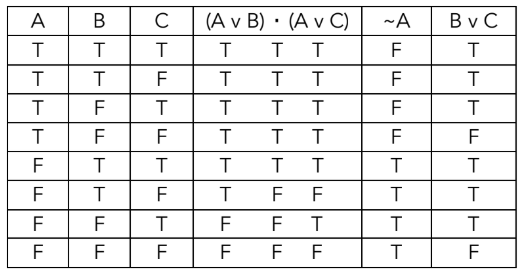
5. Invalid
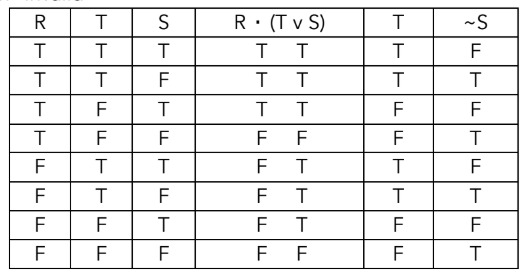
6. Invalid
7. Valid
8. Valid
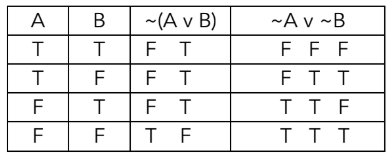
9. Valid
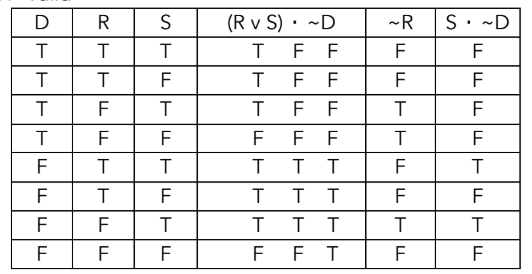
Exercise 13
1. T ⊃ I (T = The Tigers will win; I = The Indians will lose their star pitcher)
2. H ⊃ P (P = Tom will pass the class; H = Tom does all of his homework)
3. R ⊃ G (R = The car will run; G = The car has gas)
4. A ⊃ C (A = You are asking me about your grade; C = You care about your grade)
5. F ⋅ (T ⊃ B) (F = Frog will swim without his bathing suit; T = Toad will swim; B = Toad is wearing a bathing suit)
6. ~O ⊃ M (O = Obama is not a U.S. citizen; M = I am a monkey’s uncle)
7. T ⊃ ~F (T = Toad wears his bathing suit; F = Toad wants Frog to see him in his bathing suit)
8. ~P ⊃ (S v L) (P = Tom passes his exam; S = Tom is stupid; L = Tom is lazy)
9. H ⊃ W (W = Bekele will win the race; H = Bekele stays healthy)
10. (S v I) ⊃ ~W (S = Bekele is sick; I = Bekele is injured; W = Bekele will win the race)
11. P ⊃ (C ⋅ ~S) (P = Bob will become president; C = Bob runs a good campaign; S = Bob says something stupid)
12. T ⊃ P (T = That plant has three leaves; P = That plant is poisonous)
13. P ⊃ T (T = That plant has three leaves; P = That plant is poisonous)
14. P ⊃ T (T = That plant has three leaves; P = That plant is poisonous)
15. P ⊃ T (T = That plant has three leaves; P = That plant is poisonous)
16. N ⊃ O (O = Olga will swim in the open water; N = There is a shark net present)
17. O ⊃ N (O = Olga will swim in the open water; N = There is a shark net present)
18. O ⊃ B (O = Olga is swimming; B = Olga is wearing a bathing suit)
19. N ⊃ ~B (N = Olga is in Nice; B = Olga wears a bathing suit)
20. T ⊃ B (T = Terrence pulls Philip’s finger; B = Something bad will happen)
Exercise 14
1. Equivalent
2. Equivalent
3. Equivalent
4. Equivalent
5. Not equivalent
6. Equivalent
7. Not equivalent
8. Equivalent
9. Not equivalent
10. Not equivalent
Exercise 15
1. Contingent
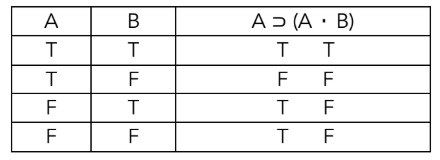
2. Tautology

3. Tautology
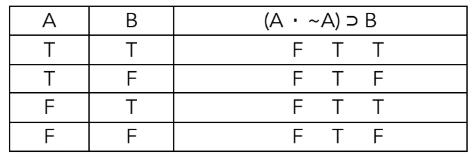
4. Contradiction

5. Tautology
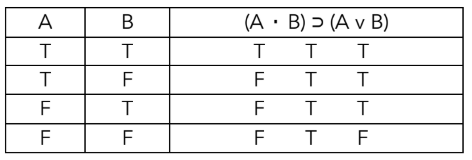
6. Contingent

7. Contingent
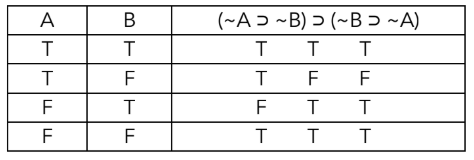
8. Tautology
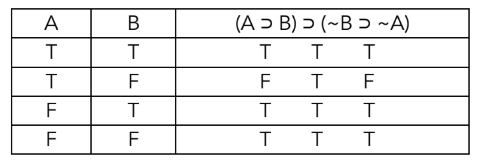
9. Contingent
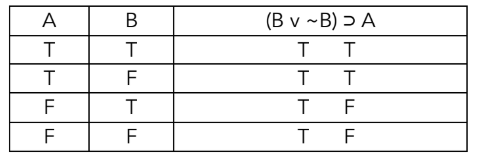
10. Tautology
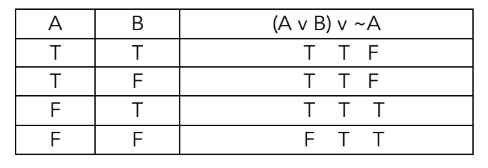
Exercise 16
1.
Simplification 1
Simplification 1
Addition 2
Addition 3
Conjunction 4, 5
2.
Disjunctive syllogism 2, 3
Modus ponens 1, 4
Modus tollens 2, 5
3.
Simplification 3
Modus tollens 1, 4
Disjunctive syllogism 2, 5
4.
Simplification 2
Hypothetical syllogism 1, 3
Modus ponens 4, 5
Simplification 2
Conjunction 6, 7
5.
Hypothetical syllogism 3, 4
Addition 1
Constructive dilemma 2, 5, 6
6.
Simplification 2
Modus tollens 1, 4
Disjunctive syllogism 3, 5
7.
Simplification 2
Modus ponens 3, 4
Simplification 2
Disjunctive syllogism 5, 6
Conjunction 4, 7
Modus ponens 1, 8
8.
Simplification 2
Disjunctive syllogism 3, 5
Simplification 2
Modus tollens 1, 7
Disjunctive syllogism 4, 8
Modus ponens 6, 9
Modus tollens 8, 10
Addition 10
Exercise 17
1.
1. A ⋅ B
2. (A v C) ⊃ D /∴ A ⋅ D
3. A Simplification 1
4. A v C Addition 3
5. D Modus ponens 2, 4
6. A ⋅ D Conjunction 3, 5
2.
1. A
2. B /∴ (A v C) ⋅ B
3. A v C Addition 1
4. (A v C) ⋅ B Conjunction 2, 3
3.
1. D ⊃ E
2. D ⋅ F /∴ E
3. D Simplification 2
4. E Modus ponens 1, 3
4.
1. J ⊃ K
2. J /∴ K v L
3. K Modus ponens 1, 2
4. K v L Addition 3
5.
1. A v B
2. ~A ⋅ ~C /∴ B
3. ~A Simplification 2
4. B Disjunctive syllogism 1, 3
6.
1. A ⊃ B
2. ~B ⋅ ~C /∴ ~A
3. ~B Simplification 2
4. ~A Modus tollens, 1, 3
7.
1. D ⊃ E
2. (E ⊃ F) ⋅ (F⊃ D) /∴ D ⊃ F
3. E ⊃ F Simplification 2
4. D ⊃ F Hypothetical syllogism 1, 3
8.
1. (T ⊃ U) ⋅ (T ⊃ V)
2. T /∴ U v V
3. T v U Addition 2
4. U v V Constructive dilemma 1, 2, 3
9.
1. (E ⋅ F) v (G ⊃ H)
2. I ⊃ G
3. ~(E ⋅ F) /∴ I ⊃ H
4. G ⊃ H Disjunctive syllogism 1, 3
5. I ⊃ H Hypothetical syllogism 2, 4
10.
1. M ⊃ N
2. O ⊃ P
3. N ⊃ P
4. (N ⊃ P) ⊃ (M v O) /∴N v P
5. M v O Modus ponens 3, 4
6. N v P Constructive dilemma 1, 2, 5
11.
1. A v (B ⊃ A)
2. ~A ⋅ C /∴ ~B
3. ~A Simplification 2
4. B ⊃ A Disjunctive syllogism 1, 3
5. ~B Modus tollens 3, 4
12.
1. (D v E) ⊃ (F ⋅ G)
2. D /∴ F
3. D v E Addition 2
4. F ⋅ G Modus ponens 1, 3
5. F Simplification 4
13.
1. T ⊃ U
2. V v ~U
3. ~V ⋅ ~W /∴ ~T
4. ~V Simplification 3
5. ~U Disjunctive syllogism 2, 4
6. ~T Modus tollens 1, 5
14.
1. (A v B) ⊃ ~C
2. C v D
3. A /∴ D
4. A v B Addition 3
5. ~C Modus ponens 1, 4
6. D Disjunctive syllogism 2, 5
15.
1. L v (M ⊃ N)
2. ~L ⊃ (N ⊃ O)
3. ~L /∴ M ⊃ O
4. N ⊃ O Modus ponens 2, 3
5. M ⊃ N Disjunctive syllogism 1, 3
6. M ⊃ O Hypothetical syllogism 4, 5
16.
1. A ⊃ B
2. A v (C ⋅ D)
3. ~B ⋅ ~E /∴ C
4. ~B Simplification 3
5. ~A Modus tollens 1, 4
6. C ⋅ D Disjunctive syllogism 2, 5
7. C Simplification 6
17.
1. (F ⊃ G) ⋅ (H ⊃ I)
2. J ⊃ K
3. (F v J) ⋅ (H v L) /∴ G v K
4. F ⊃ G Simplification 1
5. F v J Simplification 3
6. G v K Constructive dilemma 2, 4, 5
18.
1. (E v F) ⊃ (G ⋅ H)
2. (G v H) ⊃ I
3. E /∴ I
4. E v F Addition 3
5. G ⋅ H Modus ponens 1, 4
6. G Simplification 5
7. G v H Addition 6
8. I Modus ponens 2, 7
19.
1. (N v O) ⊃ P
2. (P v Q) ⊃ R
3. Q v N
4. ~Q /∴ R
5. N Disjunctive syllogism 3, 4
6. N v O Addition 5
7. P Modus ponens 1, 6
8. P v Q Addition 7
9. R Modus ponens 2, 8
20.
1. J ⊃ K
2. K v L
3. (L ⋅ ~J) ⊃ (M ⋅ ~J)
4. ~K /∴ M
5. L Disjunctive syllogism 2, 4
6. ~J Modus tollens 1, 4
7. L ⋅ ~J Conjunction 5, 6
8. M ⋅ ~J Modus ponens 3, 7
9. M Simplification 8
Exercise 18
1. All real men are things that wear pink.
2. No dinosaurs are birds.
3. All birds are things that evolved from dinosaurs.
4. Some mammals are not predators. [Already in “Some S are not P”
categorical form.]
5. Some predators are not mammals. [Already in “Some S are not P”
categorical form.]
6. Some things that wander are not things that are lost.
7. No presidents are women.
8. No boxers are rich people.
9. No things that are sleeping are things that are conscious.
10. No things that are conscious are things that are sleeping.
11. All things that end well are things that are well. [Note that this is in a different order than the sentence states. However, if you think about the meaning of the cliché, it should be clear that this is the correct order. What is being said is that as long as something ends well, it is well. It is not saying that the only things that can be well are things that end well.]
12. All things that care are things that are my friends.
13. Some person is a person who loves you.
14. All people are people who are loved by Jesus.
15. All little children are people who are loved by Jesus.
16. Some people are people who don’t love Jesus.
17. All things that use the Appalachian Trail are pedestrians.
18. All presidents are citizens.
19. All Hindus are people who believe in God.
20. No cheap things are good things.
21. Some expensive things are not good things.
22. Some mammals are not things that have legs.
23. Some couples are couples without children.
24. No people are chocolate-haters.
25. Some people are cat-haters.
26. No sharp things are safe things.
27. No poodles are things that can run faster than a cheetah.
28. No professional runner is a person that runs slowly.
29. No baboons are friendly creatures.
30. All things are things that would be eaten by a pig.
Exercise 19
1. Invalid
2. Valid
3. Invalid
4. Invalid
5. Valid
6. Invalid
7. Invalid
8. Invalid
Exercise 20
1. Invalid
2. Invalid
3. Invalid
4. Invalid
Exercise 21
1. Invalid
2. Invalid
3. Invalid
4. Invalid
5. Invalid
6. Valid
7. Invalid
8. Invalid
9. Valid
10. Valid
11. Invalid
12. Invalid
13. Invalid
14. Invalid
15. Invalid
16. Valid
17. Valid
18. Invalid
19. Invalid
20. Invalid
Exercise 22
1. Hasty generalization (you can’t infer something general from just one case here—the sample size is way too small). There is also a sampling bias present: even if many others people from Silverton, CO drove pickups, it doesn’t follow that people generally do. There is a high percentage of trucks in Silverton because the rough roads there almost require trucks.
2. Biased sample: even if he has an adequate sample size, Tom needs to sample from different times during the morning to be sure that he has a representative sample. If morning doves are disproportionately represented during the early morning hours, then his sample will be biased.
3. Even more clearly than the previous example, this one is a biased sample: even if he has an adequate sample size, Tom needs to sample from different times of the day. It is likely that morning doves will be disproportionately represented in the morning, since they are more likely to be out in the morning than other kinds of birds.
4. This example corrects the problems of the previous two: Tom has sampled from different times during the day. As long as he has taken these samples on multiple different days (preferably in different seasons too), then his sample is representative and his generalization is good.
5. Biased sample. Same problem, mutatis mutandis, as #3.
6. This seems to be a good generalization, assuming that he keeps up this regimen on multiple days. The difference, of course, is that instead of making his generalization cover the whole day, his generalization is only about the birds that land in his tree during the night.
7. Biased sample. Of course the home owners will be likely to support a policy that slashes property taxes. Most likely, those on Medicaid (governmental health care support for the elderly) will not be homeowners but will be in nursing home facilities. If the poll had been administered to Medicaid recipients (who are less likely to own homes), the results would likely have been different.
8. This seems a good generalization. Telephone polls are a good way of getting a random sample, and the sample size is large enough if a good random sampling technique is used.
9. Sampling bias because of the biased way the question is asked: “killing innocent children” uses strong, evaluative language and may influence how people answer, making them more likely to choose option b over option a (who wants to say they support “killing innocent children”?).
10. Steve’s problem is that he has gotten a biased sample. Ani Difranco concert-goers are not representative of concert-goers tout court. Since Ani Difranco is very political (and from a feminist perspective), we should expect to see a much higher proportion of such speech at an Ani Difranco concert. In contrast, Tom Petty is about a apolitical as any musician.
11. Biased sample. We should expect students in detention to be less satisfied, on average, than students generally. Thus, since the principal’s survey was only administered to students in detention, the rate of dissatisfaction will be much higher, which will make the sample unrepresentative and the generalization bad.
12. This seems to be a good generalization. Her generalization only covers “all Pistons games” (rather than all NBA games or all professional sports games, more generally) and she has attended many games over many years. Thus the sample seems to be both representative (i.e., non-biased) and large enough.
13. Unlike the last example, Alice’s generalization now applies to all NBA games, but still uses only her experience at Pistons games. But unless we are given some reason for thinking that Pistons games are representative of all NBA games, we should not assume that Pistons games are representative of all NBA games. Thus, the sample is probably biased (although we do not know for sure that it is, we cannot assume it isn’t without further investigation).
14. Even more than the last example, this one is biased sample. Unless we have a good reason for thinking that Pistons games are representative of all professional sporting events, we cannot assume that they are.
15.Although we can understand Bob’s fear, this is clearly a hasty generalization since he is generalization from only one case at one Burger King to all Burger Kings, all the time.
Exercise 23
(Note: for many of these, there is more than one correct answer. The important thing to do is to give the correctly explanation for why the explanation lacks the virtue you have chosen.)
1. This could be any number of them, including: depth (why would the aliens have kidnapped him and then returned him to his home?), power (this explanation cannot be used in a range of different circumstances—a better explanation is simply that he has some kind of amnesia), or simplicity (if we don’t have any other reason to admit there are aliens, then we should simply chalk it up to some kind of amnesia).
2. Modesty. There is no reason she should posit all of those specific details about the badger, even if it was a badger. However, even just saying it’s a badger or a large rodent is an explanation that seems to lack simplicity. If houses naturally creak and windows rattle from the wind, then positing a large rodent seems unnecessary. A better explanation would simply be that the house creaks naturally as it slightly shifts and the wind is rattling the windows.
3. Simplicity and modesty. It is simpler to simply assume that there is someone who looks like Bob, whether or not he is Bob’s identical twin. It is also more modest since positing someone who looks like Bob could include someone that is Bob’s identical twin, but also leaves open the possibility that it’s just an unrelated person who happens to look like Bob. The explanation might also lack power insofar as it raises more questions than it answers. For example, why did Bob never tell you about his identical twin?
4. Conservativeness: people don’t die and come back to life, as far as we know. Thus, we could also say it lacks power since this kind of explanation doesn’t apply in any other cases we know. A better explanation is that there is someone who looks just like Tom.
5. Modesty. Like #3, a more modest explanation is that this is someone who looks like Tom, whether or not it is Tom’s son. The explanation might also lack depth since we would want to know why you had never seen or heard of Tom’s son for 20 years.
6. The last line is the giveaway: this explanation lacks falsifiability. The reason is that Elise says that there is no way to prove that this happened (she just knows it). The explanation also lacks depth since we would want to know why and how this replacement was done!
7. If this explanation lacks an explanatory virtue, it is probably falsifiability: there is no way (within current science) to show that there wasn’t such a being. Furthermore, it might also lack depth since it raises the question: where did this all-powerful being come from?
8. Modesty. Why think that it is her 5th grade teacher rather than just some person following her? The explanation is far more specific than it needs to be in order to explain the observations she has made. Thus, it lacks modesty.
9. Again, this explanation lacks modesty. Why not just say that it is “an animal” rather than “an escaped zoo animal.” Unless she has some evidence relevant to the escaped zoo animal hypothesis, she should just leave it at the more general “animal” hypothesis. Furthermore, the explanation may be said to lack power, as well. Since most such noises are made by creatures in the wild, not escaped zoo animals, the “creatures in the wild” explanation is more powerful, since it is used to explain a much wider range of similar observations (i.e., hearing rustling in the bushes and sticks cracking on the ground while in the woods).
10. Simplicity. The simpler explanation is that Bill was speeding, not that they had tracked his overdue library book. It also lacks power since most of the time when people are pulled over on the highway it is for speeding, not unreturned library books.
11. This is a good explanation and seems to lack no explanatory virtue.
12. This explanation clearly lacks modesty. Why say that someone was going precisely 13.74 mph over the speed limit rather than saying that they were going over the speed limit (without specifying how far)? That specificity is not justified by the observed facts.
13. Conservativeness. We have no good reason for positing some whole new breed of rats—especially if the claim is that they evolved in her apartment only. This would violate what we know about how evolution works (i.e., we probably need a much larger population for this to happen than the population of rats that are contained in only her apartment). Furthermore, the explanation lacks power since a better explanation that applied to a wider range of circumstances is simply that the rats were not taking the bait.
14. Even more clearly than #13, this one lacks conservativeness. There are no known cases of anything being immortal and this idea violates our understanding of the basic laws of nature. Nothing is immortal.
15. Again, this explanation lacks conservativeness (i.e., it violates our understanding of nature which says that nothing is immortal). A better explanation is that the bullets Bob put in his gun were blanks (cf. the movie, Crash).
Exercise 24
1. Weak: if the painting is hanging in your high school, it probably isn’t a Rembrandt. That is the disanalogy: even if the colors are very similar, almost all Rembrandts hang in galleries, not in high schools.
2. Weak. Although the similarity is that they are both poodles, there is probably some other characteristic that accounted for me being bitten. That is, it probably wasn’t the fact that the dog that bit me was a poodle, but more likely that I was invading its space or it felt threatened, etc. It could have likely been some other breed in the same circumstances. So it isn’t “poodleness” that accounts for the biting. That said, if we had evidence that poodles are much more likely to bite than other breeds then this argument would be stronger.
3. Strong. Unlike, the last one, this argument delivers a much stronger analogy between past events (poodle-encounters and poodle-bitings) and the current event (poodle-encounter).
4. Strong. The relevant similarities are: 1) Van Cleave’s class doesn’t change much from semester to semester, 2) the person has the same abilities as their friend who got the A.
5. Weak. Although both are crimes, there are many relevant differences between committing rape and robbing a bank.
6. Weak. There is no particular relationship between having seats, wheels, and brakes, on the one hand, and being safe to drive, on the other. So having seats, wheels and brakes is not a relevant similarity between the two cars, if what we are interested in is how safe they are.
7. Strong. The car company (Volvo) is a relevant similarity between the old cars and the new car. We can expect similar quality between cars from the same company. In contrast, knowing that a car as wheels, brakes and seats tells us essentially nothing about its quality, including its safety.
8. Strong.
9. Weak. A birthday party and a funeral are not relevantly similar in this case. A funeral is a much more important family event than a birthday party (typically). So we should not expect similarity with respect to a professor’s absence policy when comparing birthday parties to funerals.
10. Weak. Although both may influence happiness, the relevant difference is that whereas heart and brain surgery are typically a matter of life and death (and hence much more likely to be paid for by insurance), cosmetic surgery is not a matter of life and death.
11. Weak. Although a knife and spoon share the property of being eating utensils, that is not a relevant similarity on which we can expect that they will share functional properties like cutting.
12. Whether this famous argument for the existence of God is strong or weak is a matter of some debate. One reason for saying it is a weak argument is that there is a disanalogy between artificial objects and natural objects, since complex natural objects may evolve without being designed by an intelligent designer, whereas no artificial objects (yet) can evolve on their own.
13. Weak. Running the same number of miles as an elite runner is not a relevant similarity for determining how fast one will run a race. The relevant dissimilarity here is that although Bekele runs his mile repeats at close to 4:00 flat, I can only run mine at 5:30. So it is the pace at which one runs, rather than the number of miles one runs, that is the better predictor of how fast one can run a race.
14. Strong. The fact that we are both humans is relevant to determining whether someone will feel pain. Humans all have similar physiology, which is why we should expect that if x causes one person physical pain, then x will also cause anyone else a similar pain. (However, this argument also raises a famous problem in philosophy of mind called “the problem of other minds.” The issue is whether or not we can ever know that people have mental states, such as pain, like my own. Even if you exhibit pain behavior in similar instances in which I experience pain, how do I know that you are actually feeling what I am feeling—that you are having the experience of pain, rather than simply exhibiting pain behavior without have the mental experience of it? Many philosophers have argued that we cannot overcome this problem and must admit that we cannot know whether people other than ourselves actually have mental states like ours.)
15. Again, the common sense answer would be that this is a strong argument based on a strong analogy. Since you and I are both human and share similar perceptual systems, we should expect that we will perceive the world very similarly (even if not exactly the same). (However, we can raise the same “problem of other minds” problem here as I did in #14 above. Suppose we both point at the grass and say that it is green. However, how do I know that your experience of green is like my experience of green? Maybe your experience of green is more like my experience of red and vice versa.)
Exercise 25
1. C is sufficient since any time it is present, the target G is present. Both C and D are necessary, since any time the target G is present, they are present.
2. A and C are sufficient; A and C are also necessary.
3. C and D are necessary. All candidates are sufficient, since there is never a case where a candidate is present but the target is absent. However, the test for sufficient conditions is not rigorous, since there is no case in which the target is absent (hence, it is trivially true that there is no case in which a candidate is present when the target is absent).
4. No one candidate is sufficient (case 1 rules them all out). Only C is necessary.
5. C is sufficient; B, C, and D are necessary.
6. None are sufficient (case 1 rules them all out); A and D are necessary.
7. B is sufficient; A, B and D are necessary.
8. C is sufficient; A, B, C, and D are all necessary. However, the test for necessary conditions is not rigorous, since there is no case in which the target is present (hence, it is trivially true that there is no case in which a candidate is absent when the target is present).
9. B and C are sufficient; C and D are necessary.
10. A and C are sufficient; D is necessary.
Exercise 26
1. Accidental
2. B causes A. Perhaps when we are away from home, Charlie gets less exercise, hence putting on more weight. In that case B is (indirectly) causing A, since our being away from home results in Charlie getting less exercise, which results in him gaining more weight.
3. Common cause. The common cause is simply the factors that make plants grow, such a sunlight, water, and good soil. In this case, A and B are not causing each other, but there is something else (i.e., growth factors of plants) that is causing each one, independently to grow.
4. A causes B. The more bombing, the more stress for the president. And the more stress for the president, the more of his hairs fall out.
5. B causes A. Arguably, the average number of fires per year will influence the number of fire engines needed. Fewer fires would require fewer engines (in which case they’d likely retire some); more fires would require more engines (in which case they’d likely acquire some).
6. Common cause: agrarian societies will have more mules and will also probably pay professors less, since higher education is not as important in an agrarian society. So the common cause is being a (more or less) agrarian society.
7. B causes A. Drivers are distracted by the scantily-clad models on the billboards and more distracted drivers causes more accidents.
8. A causes B. The wider one’s waist, the higher the weight due to fat. The higher the weight due to fat, the lower one’s vertical leap.
9. B causes A. The heat causes slower marathon times.
10. Common cause: Ageing. The older one is, the more likely one will have gray hair and the more likely one will have more children or grandchildren. However, neither of these factors are causing the other. Rather, both are being caused independently by a common factor: age.
Exercise 27
1. 1/6
2. 5/6
3. 1/36
4. 1/36
5. 12/36 or 1/3
6. 1/6 + 1/6 – 1/36 = 11/36
7. 2/6
8. 1 – 12/36 = 24/36 = 2/3
9. 1/36
10. 6/36


